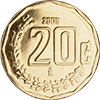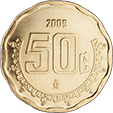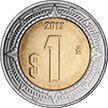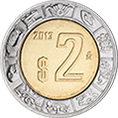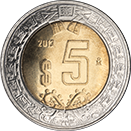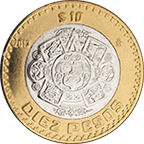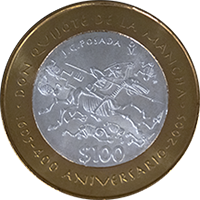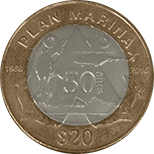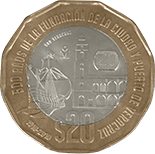On May 11, 2004, the Mexican Legislative Power modified Articles 4 and 5 of Mexico’s Monetary Law, which came into effect January 1, 2006, as follows:
- Article 4. “Banco de México’s banknotes will remain unlimited legal tender and must contain one or several features that allow visually impaired persons to identify their denomination.”
- Article 5. "The metallic coins referred to in paragraphs b) and following of Article 2 of this law, will remain unlimited legal tender, limited to the value of one hundred coins of each denomination in the same payment.
- Said coins shall be minted in such a way as to allow visually impaired persons to identify their denomination.”
Banknotes
Marcas hápticas en los billetes de la familia D1
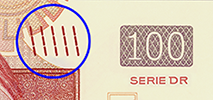 |
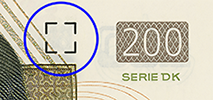 |
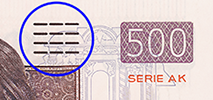 |
These banknotes belong to the D1-type, which includes 20-, 50-, 100-, 200-, 500- and 1000-peso denominations. All denominations of this banknote type have intaglio and embossing perceptible by touch on the words "BANCO DE MEXICO", the hero, the image and the denomination. The 100-, 200-, 500- and 1000-peso banknotes also have intaglio and embossing perceptible by touch in the color-shifting element.
Relieves en los billetes de la familia D1
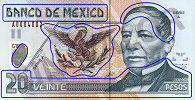 |
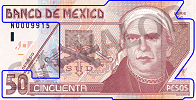 |
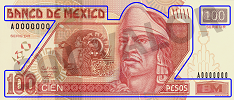 |
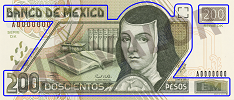 |
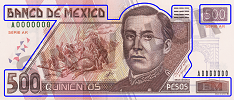 |
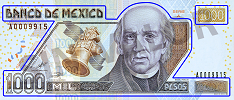 |
The 20-peso banknote also has intaglio and embossing on its clear window, where a number “20” and parallel diagonal lines are found. This banknote started circulating in 2002 and was the first to be printed in polymer. Its texture, different from that of banknotes manufactured in cotton paper, as well as its clear window, allowed to distinguish it from the rest of the banknotes.
Ventana transparente en el billete de 20 pesos de la familia D1
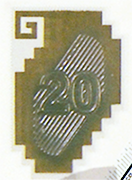 |
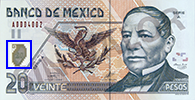 |
The color of each denomination is another distinctive feature in this banknote type. It is useful to facilitate the identification of the banknote denomination for people with impaired vision.
Subsequently, between November 2006 and August 2010, the F-type banknotes were gradually put into circulation. They consist of six denominations: 20, 50, 100, 200, 500 and 1000 pesos. In this banknote type, the 20- and 50-peso denominations are made of polymer, and the rest are made of cotton paper.
The 100-, 200- and 500-peso denominations retained the embossing and intaglio for visually impaired people that were present in their D1-type versions. The intaglio and embossing were included in the 1000-peso denomination. They consist of two concentric circles, each formed by four broken lines and a central dot.
Marcas hápticas en billetes de algodón de la familia F
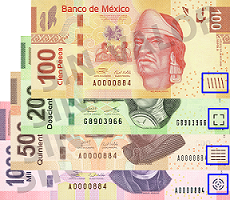 |
 |
 |
|
 |
|
 |
Additionally, all denominations of this type have intaglio and embossing perceptible by touch in the words "BANCO DE MEXICO", the hero, the image, the denomination, the color-shifting element, and the legend.
Relieves en los billetes de la familia F
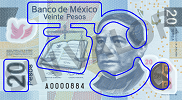 |
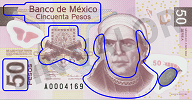 |
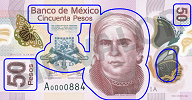 |
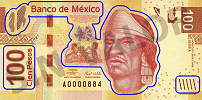 |
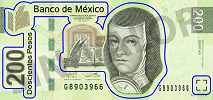 |
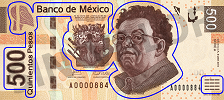 |
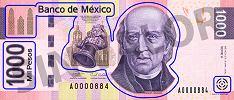 |
The 50-peso denomination had two designs, the second with new security features, including a double clear window. The 20-peso denomination and the first design of the 50-peso denomination have a clear window with intaglio and embossing perceptible by touch of the denomination number and parallel diagonal lines.
Detalle en la ventana transparente de los billetes 20 y 50 F
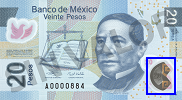 |
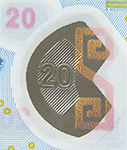 |
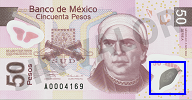 |
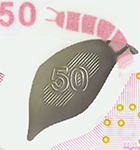 |
In the lower clear window of the second design of the 50-peso denomination, the intaglio and embossing perceptible by touch consist of a number “50” and wavy lines.
Detalle en la ventana transparente del billete 50 F1
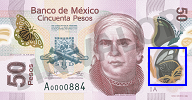 |
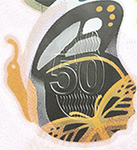 |
F-type banknotes were designed with 7 mm length differences between one denomination and the next, with the smallest banknote denomination (20 pesos) measuring 120 mm and the largest (1000 pesos) 155 mm. After conducting several studies, Banco de México designed a clipboard facilitating the identification of F-type banknote denominations by visually impaired people. The clipboard is made of plastic and allows identifying banknote denominations by their length differences and the use of Braille characters. These clipboards started to be distributed in November 2012.
In this banknote type, the distinctive color of each denomination facilitates their identification by visually impaired people.
Diferencia de tamaño en billetes de la familia F y primera tablilla
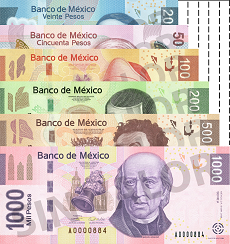 |
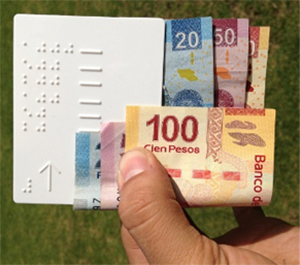 |
The next banknote type (G-type) was put into circulation gradually between 2018 and 2021. It consists of 50-, 100-, 200-, 500- and 1000-peso denominations, besides a 20-peso banknote commemorating the bicentennial of Mexico's Independence.. Additionally, if required to meet the public's needs, the 2000-peso denomination could be added. In this banknote type, the 20- commemorative, 50- and 100-peso denominations are made of polymer, and the rest are made of cotton paper.
The 200-, 500- and 1000-peso denominations have intaglio and embossing perceptible by touch that facilitates identification of each denomination to visually impaired people. The intaglio and embossing are located on the upper left and right edges on the obverse of each banknote and consist of two lines for the 200-peso denomination, three lines for the 500-peso denomination, and four lines for the 1000-peso denomination.
Marcas hápticas en billetes de la familia G
 |
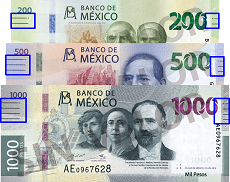 |
 |
 |
 |
|
 |
 |
Banknotes of this type (family) also have tactile embossing in the text “BANCO DE MÉXICO”, the main figure (character) and main motive, in the vignette accompanying the main figure, in the denomination number, in the inscription, and in the diagonal lines.
Relieves en billete de la familia G
 |
 |
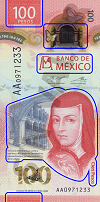 |
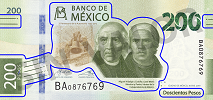 |
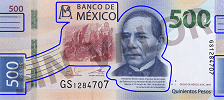 |
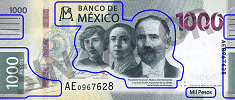 |
In the transparent window of the 20-peso banknote commemorating the Bicentennial of Mexico’s Independence, there is also embossing in the number 20 at the center and in the texture of lines across the entire width of the banknote with two dots on each end; and in the 50-peso banknote, in the number 50 and in the texture of five dots forming a half circle. In the transparent window of the 100-peso banknote there is embossing in the number 100 and in the vertical lines.
Detalle de la ventana transparente en el billete 100 G
 |
 |
 |
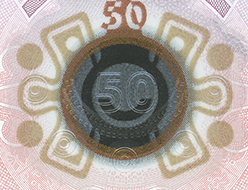 |
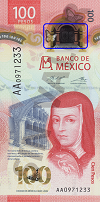 |
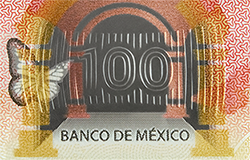 |
G-type banknotes were also designed with a 7 mm length difference between one denomination and the next, with the smallest denomination (50 pesos) measuring 125 mm and the highest (1000 pesos) measuring 159 mm. The 20-peso banknote commemorating the bicentennial of Mexico's Independence keeps the same lenght as the 20-peso banknote corresponding to the F-type, this is 120 mm. If deemed necessary for meeting the needs of users, the 2000-peso banknote will be 6 mm longer than the 1000-peso banknote.
For the above reasons, Banco de México designed a new banknote clipboard to identify the denomination of F- and G-type banknotes. The distribution of this clipboard started with the entry into circulation of the 200 -peso banknote in September 2019.
In this banknote type, colors difference between denominations makes easier to distinguish one denomination from the next to visually impaired people.
Nueva tablilla de billetes y diferencia de tamaño en los billetes G
| A. Folding-back upper side | 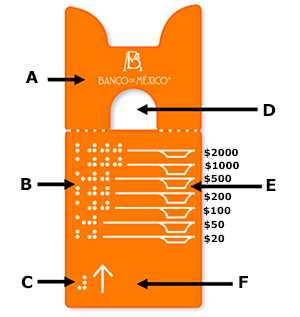 |
D. Slot |
| B. Banknote denominations printed in Braille | E. Stops for indicating denominations | |
| C. Braille number sign | F. Arrow indicating the adequate position to use the clipboard | |
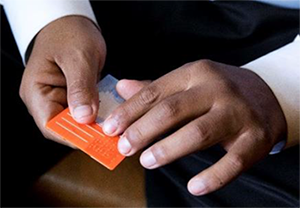 |
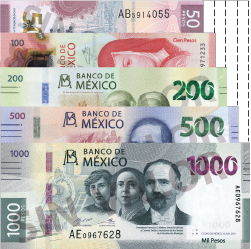 |
|
Coins
The features useful to identify coins are size, edge and, in some cases, color and shape.
When Articles 4 and 5 of Mexico’s Monetary Law were modified, 5-, 10-, 20- and 50-centavo, as well as 1-, 2-, 5- and 10-peso coins were minted. These coins had size differences, and except for the 20- and 50-centavo coins, they had a twelve-sided and notched shape. The rest were round: 5-centavo and 5-peso coins have plain edges, while 10-peso coins have a milled edge.
As for color, the 5- and 10-centavo coins were silver while 20- and 50-centavo coins were gold. The 1- to 10- peso coins correspond to the designs currently minted; 1- to 5-peso coins are bimetallic, with a gold core and a silver perimeter ring, and the 10-peso coin is bimetallic, with a silver core and a gold perimeter ring.
Monedas de 5 a 50 centavos ay sus respectivos cantos
|
5-centavo coin, round |
10-centavo coin, round |
Plain edge in 5- and 10-centavo coins |
|
20-centavo coin, twelve-sided and notched shape |
50-centavo coin, twelve-sided and notched shape |
Plain edge in 20- and 50-centavo coins |
Monedas de 1 a 10 pesos y sus respectivos cantos
|
1-peso coin, round |
2-peso coin, round |
5-peso coin, round |
Plain edge in 1-, 2-, and 5-peso coins |
|
10-peso coin, round |
Milled edge in 10-peso coin |
Between 2003 and 2007, 100-peso coins were put into circulation, to commemorate different events. The coins of this denomination were circular and bimetallic, with a silver core and a gold perimeter ring. In this denomination, the edge was interrupted milled and the size (39 mm) was larger than that of the 10-peso coins (28 mm) and the 20-peso coins (32 mm) that were put into circulation in 2000.
Monedas de 100 pesos y su canto
|
100-peso coin, round |
Interrupted milled edge |
In 2009, new designs of 10-, 20- and 50-centavo coins were put into circulation, which correspond to those currently minted. They are smaller in size than the previous 10-, 20- and 50-centavo coins and are silver-plated and each has a different edge, which is the main feature used that visually impaired people use to differentiate them from each other. In the 10-centavo coin, the edge is slotted; the 20 centavo-coin has an interrupted milled edge, and the 50-centavo coin has a milled edge.
Monedas de 10, 20 y 50 centavos, y sus respectivos cantos
|
10-centavo coin, round with slotted edge
|
20-centavo coin, round with interrupted milled edge
|
50-centavo coin, round with milled edge
|
The 20-peso denomination has been used to commemorate different events. Since the designs put into circulation in 2000 and until 2018, the features of these coins were as follows: round shape, 32 mm diameter, with an interrupted milled edge and bimetallic composition, with silvered core and golden perimeter ring.
As of 2020, the shape and size of 20-peso coins changed to facilitate their identification to visually impaired people; they are no longer round but twelve-sided and their diameter is now of 30 mm. Their edge continues to be interrupted milled and they are still bimetallic, with a silvered core and a golden perimetric ring. In addition, these designs have a security feature called "latent image" which, although not functional for visually impaired people, has a design based on parallel stripes, thus providing another feature which helps identify this denomination.
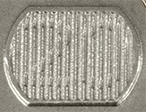
Latent image of the 20-peso coin commemorating the centennial of the city and port of Veracruz
Moneda de 20 pesos y su canto
|
20-peso coin, round with interrupted milled edge
|
20-peso coin, twelve-sided with interrupted milled edge
|



